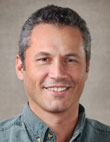
Nuclear Medicine Born
At Lab 71 Years Ago
|
|
|
|
 |
 |
|
|
John Lawrence |
|
|
|
A radioactive isotope was used to treat human disease for the first time on Dec. 24, 1936, at Berkeley Lab, marking the birth of nuclear medicine. Ernest Lawrence, who would soon win the Nobel Prize in Physics for his invention of the cyclotron, recognized the medical potential of nuclear isotopes. The key was bringing in his brother John Lawrence, who began treating a 28-year-old leukemia patient using a radioactive isotope of phosphorus-32 produced in one of his brother's cyclotrons. Full story.
Venture Capitalist Joins
In Effort to Save Planet
|
|
|
|
 |
 |
|
|
|
|
|
|
There's little about the building where Vinod Khosla runs his tiny venture-capital firm to suggest he's at the forefront of a global effort to revolutionize how the world gets energy. Yet, saving the planet is what Khosla and a growing number of financiers, entrepreneurs and political luminaries hope for as they chase new ways to wean the world from oil, coal and other non-renewable energy sources now threatening the environment. Some of the most promising research in renewable energy is in wind generation and solar thermal — using the sun's energy to create steam that powers generators of electricity, says Berkeley Lab Director Steve Chu. Full story.

Cable Boxes Gobble
Up Lots of Energy
|
|
|
|
 |
 |
|
|
Nordman |
|
|
|
Many appliances continue to burn electricity even when they’re turned off because they remain in standby mode, and among the worst offenders are cable boxes. Bruce Nordman, with Berkeley Lab’s Environmental Energy Technologies Division, said some set-top boxes for cable and satellite can use about 25 percent more electricity an hour than a newer model refrigerator. The boxes should be designed to power down when not in use, Nordman said. “But (the manufacturers) haven’t bothered to do that because they’re not paying the electric bill. So it’s free to them.” Full story.
 |

